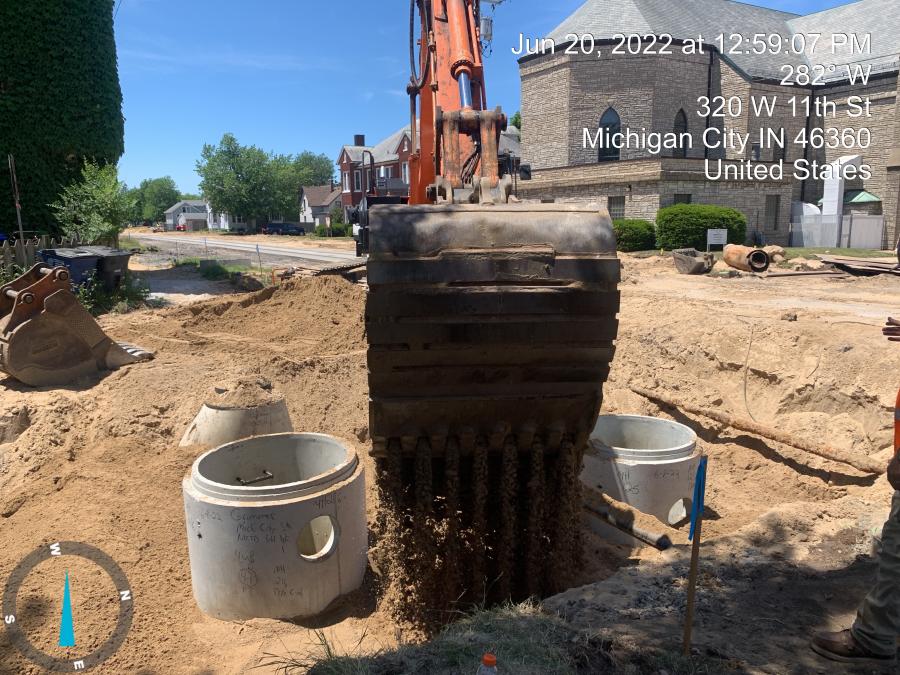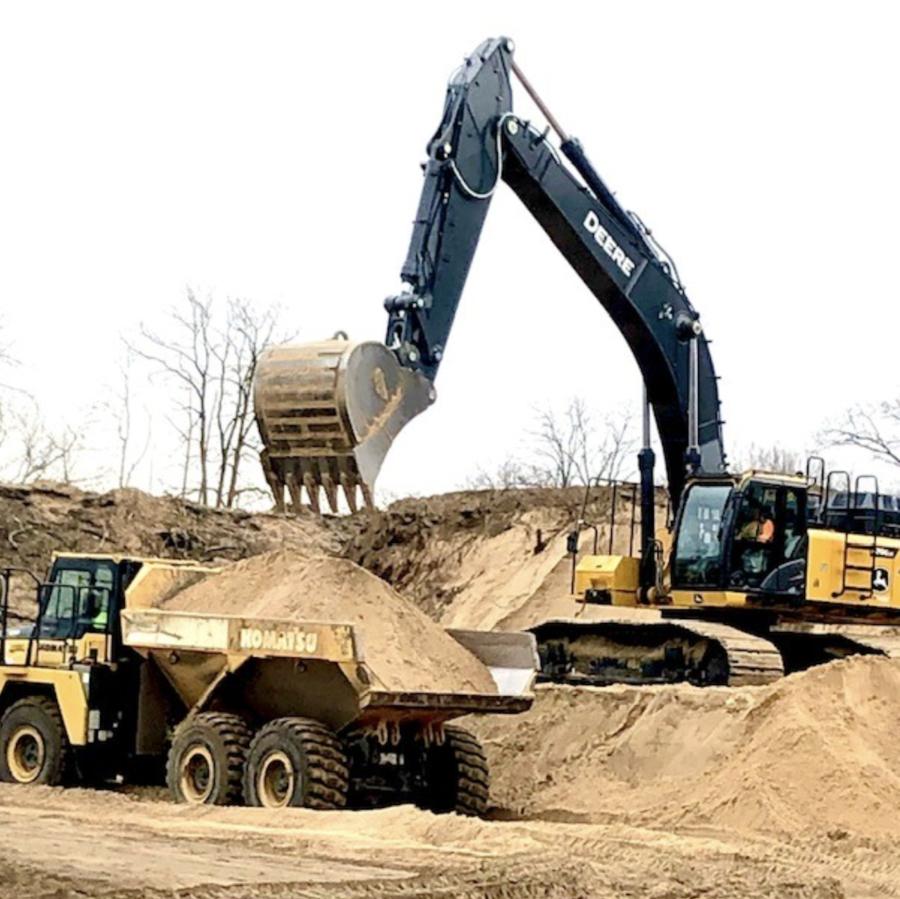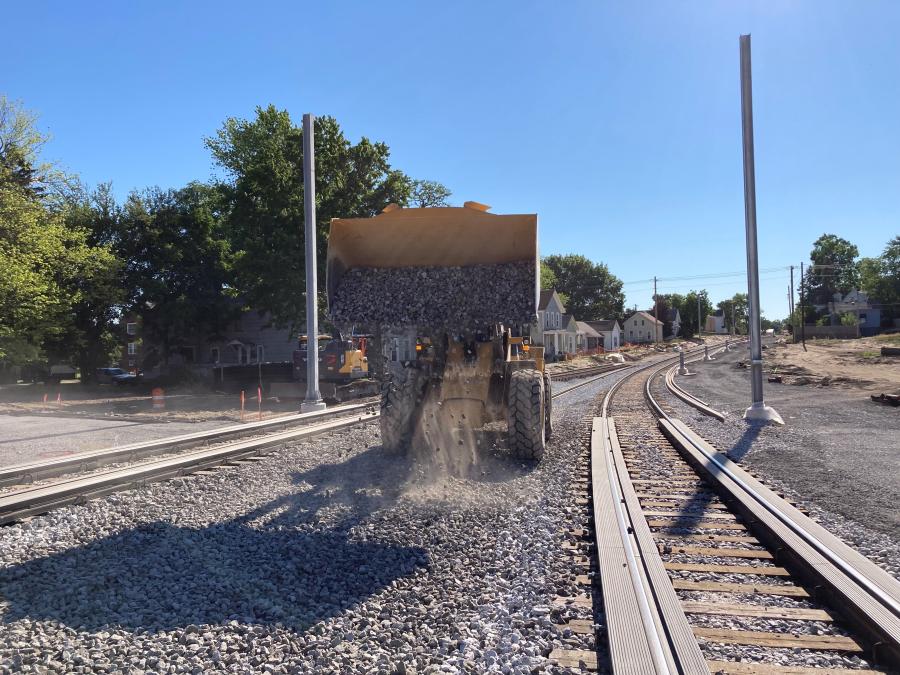Construction has begun on a $640 million undertaking known as the Double Track Northwest Indiana Project.
(NICTD/South Shore Line photo)
Construction has finally begun on a $640 million undertaking known as the Double Track Northwest Indiana Project. The long-awaited work includes building more than 26 mi. of new second track between Gary and Michigan City along Northern Indiana Commuter Transportation District's (NICTD's) existing South Shore Line (SSL).
"Elements include approximately two miles of completely new right-of-way in Michigan City; platform reconfigurations at five stations; construction of 1,475 additional parking spaces; a new overhead catenary power system; and reconstruction of 22 at-grade crossings and 20 culverts," said NICTD's Nicole Barker, Double Track NWI project manager. "The project is expected to improve safety along the entire alignment, especially in Michigan City, where the new alignment will remove the street-running track; eliminate 13 grade crossings; and provide a safer environment for passengers boarding trains."
Once the work is complete, SSL will be able to operate more trains during rush hour and reduce travel time between Michigan City and Chicago. In addition to increased economic benefits, the project will provide more competitive travel options.
Plans call for a new station and two new high-level six-car platforms at Gary/Miller Station, along with one eight-car storage track and one four-car storage track for additional rush hour trains and an additional 519 parking spaces. At Portage/Ogden Dunes Station there will be one new high-level six-car platform on the south side of the tracks and an additional 327 parking spaces. Other major upgrades will take place at Dune Park Station, Beverly Shores Station and 11th Street (Michigan City) Station.
The latter includes removal of embedded street-running track along 10th and 11th Streets; two new tracks south of the 10th Street ROW from Sheridan Avenue to the Amtrak crossing near Chicago Street; two new tracks along 11th Street; one high-level four-car platform; one high-level eight-car platform; a new station house with a parking structure with 437 additional spaces; and a new surface parking lot with 108 additional spaces and conversion of 11th Street to one-way automobile traffic.
"In the opening year, service is planned to operate every 16 minutes during weekday peak periods and approximately every 75 minutes during weekday off-peak periods and evenings," said Barker. "In the horizon year, service is planned to operate every 14 minutes during weekday peak periods and approximately every 70 minutes during weekday off-peak periods and evenings. In both the opening and horizon years, service is planned to operate every 135 minutes on weekends."
The expected ridership, using current year inputs of population and employment, is 6,000 daily linked trips. This number is expected to grow to 9,700 daily linked trips by horizon year 2040.
"This is a good time to perform the work, in that temporary reductions in ridership due to COVID allowed construction contractors to have maximum access to the rail corridor for construction purposes," said Barker.
Construction began in early 2022 and will end in mid-2024. WSP USA Inc. is the construction manager of the project, with Walsh/Herzog Joint Venture serving as the primary contractor. Six smaller contractors, including Grimmer Construction, are handling select portions of the work.
"It's incredibly exciting to be in the actual construction phase," said Barker. "I've been working for the past seven years to get to this point. The entire team has worked so hard to get here, including our project partners at the Federal Transit Administration, Regional Development Authority, Indiana Finance Authority, the state of Indiana and other regional/local partners. It truly took a strong federal, state, regional and local collaborative effort to make this happen. Now, everyone is laser focused to bring the project in on time and within budget.

"The project will provide major improvements to travel time, which is already driving development and drawing people to the area. In essence, most commuters to downtown Chicago travel around one hour, and this project will place a large portion of our system within that hour. Given our wonderful quality of life, adjacency to natural beautiful nationally recognized landscapes like the dunes and vibrant communities, more people will be calling northwest Indiana home as a result."
Barker noted that monitoring material availability has been critical, as the pandemic affected global supply chains and product availability.
"NICTD procured various items ahead of time to minimize risk, which was a great decision. There are various natural resource restrictions that don't allow certain activities within certain windows to protect species of concern, such as the Indiana bat. The construction teams must carefully sequence work to ensure all work remains within those windows. The seasonality of work, when overlaid on those restrictions, requires careful attention to small schedule shifts to ensure everything is in alignment.
"We are busing most of our riders during the two-year construction period, which is a challenge for NICTD and our passengers. There also are four bridges that will be constructed. Lastly, having multiple cutovers as we return segments of track into service, along with requisite commissioning and testing and ensuring operability of our Positive Train Control system, are integral to the success of the project."
Barker explained that moving the street-running tracks along 10th and 11th Streets in Michigan City is among the necessary tasks for crews.
"On 11th Street, space is very limited. As a result, we are converting the roadway from a two-way to a one-way single lane street on a permanent basis. The track will be fully separated from the roadway. On 10th Street, we acquired all the houses south of the tracks so we could shift our tracks out of the road and be fully separated from the roadway in the permanent condition."
Currently, substantial work is taking place in Michigan City, with construction expected to end in the area in November. Crews also are installing culverts throughout the project, and major sewer work is under way in Gary. Teams are preparing to begin construction of the new Miller Station this year. A new parking lot in Miller is already under construction and a new parking lot at the Portage/Ogden Dunes Station is under way.
"We have just under 20 culverts being replaced or repaired as part of the project, four which are very large, major culverts," said Barker. "We have had some unforeseen conditions we've had to work around, but Walsh/Herzog has done a great job working with us to solve these challenges."
Building the four new bridges includes installation of steel pile foundations; construction of concrete piers and abutments; fabrication of welded steel superstructures; and steel erection over mainline tracks of two Class I railroads, a steel mill main entrance and a city roadway.
To create parking spaces, workers are using a permeable pave drain technology in most of the parking areas. This system will allow water to infiltrate and help eliminate retention basins, which is beneficial from an environmental and aesthetic standpoint.
Demolition involved 70 total structures that had to be removed, including residential and commercial properties. The severely fire-damaged First Christian Church also was torn down, and involved disassembling the structure, including the large copper domes on the roof. The cross was sent to another local church.
Extensive sewer relocations have occurred, with major utilities also being moved to prepare for construction over the more than 26 mi. This particular effort was led by NIPSCO, the local gas and electric company that was once part of the ownership of the railroad.
As construction continues on the project, safety remains a priority. Prior to stepping onto the job site, workers were required to take an online training course from the railroad. Topics included working on or about the tracks and high-voltage electrical lines; defining fouling the tracks; roadway worker job briefings on track safety methods; and working around roadway maintenance machines.
Heavy equipment on the job includes John Deere 700L and John Deere 650K dozers; John Deere 245G and John Deere 345 excavators; a Harsco Mark IV tamper; a Nordco spike puller; a Nordco spiker and 100-ton ballast cars.
A total of 400,000 tons of aggregate, 10,600 cu. yds. of concrete; 257,000 liner ft. of new rail and 80,000 new rail ties are among the chief materials required to complete the project.
While much work remains, Barker said it's incredibly rewarding to play a role in the Double Track project.
"Everywhere I go on my time off, people approach me to ask questions about the status, enthusiastic about how it will benefit the area once done. Knowing how much it means to the community makes me work as hard as I can every day." CEG
Today's top stories






















